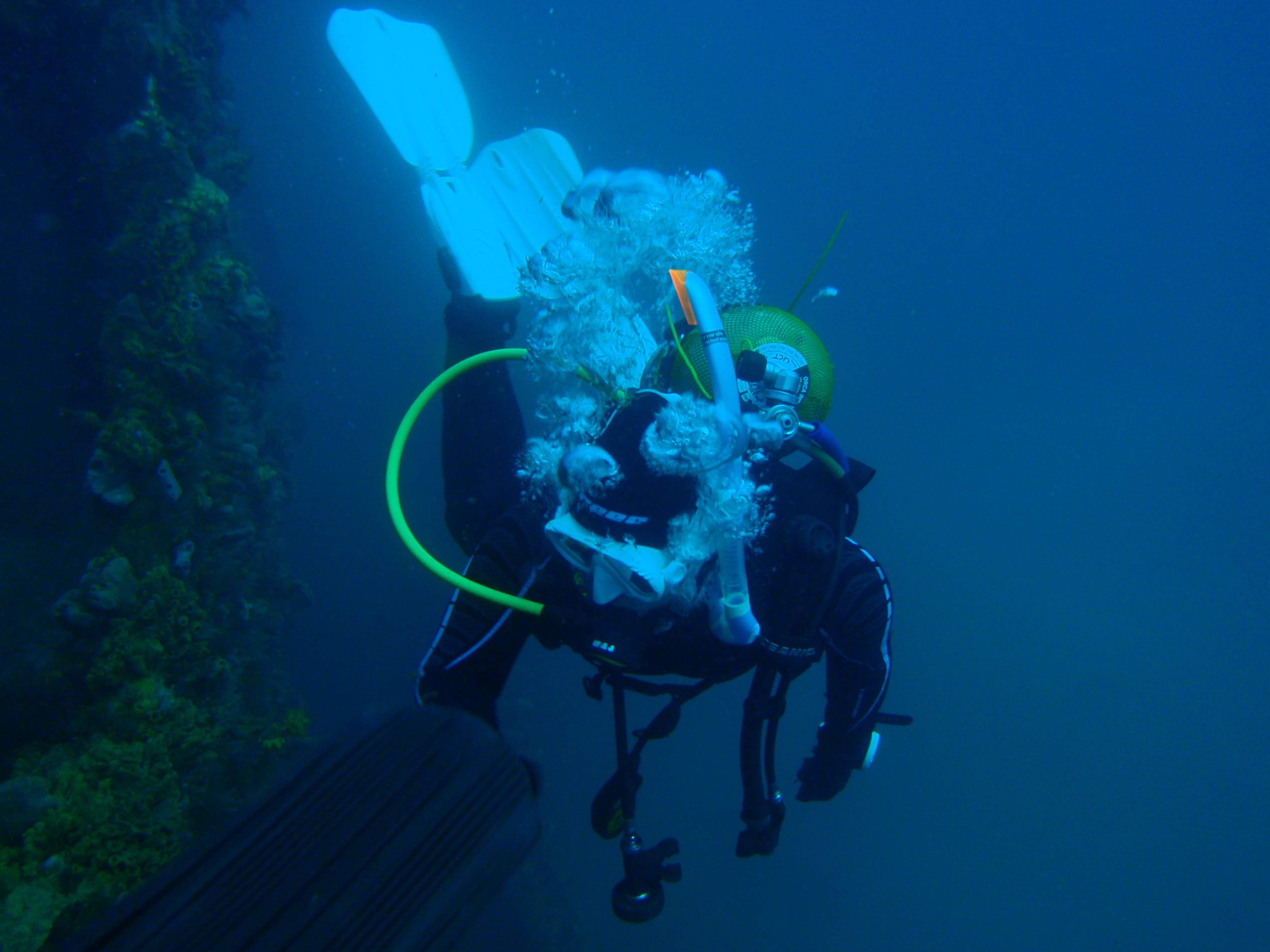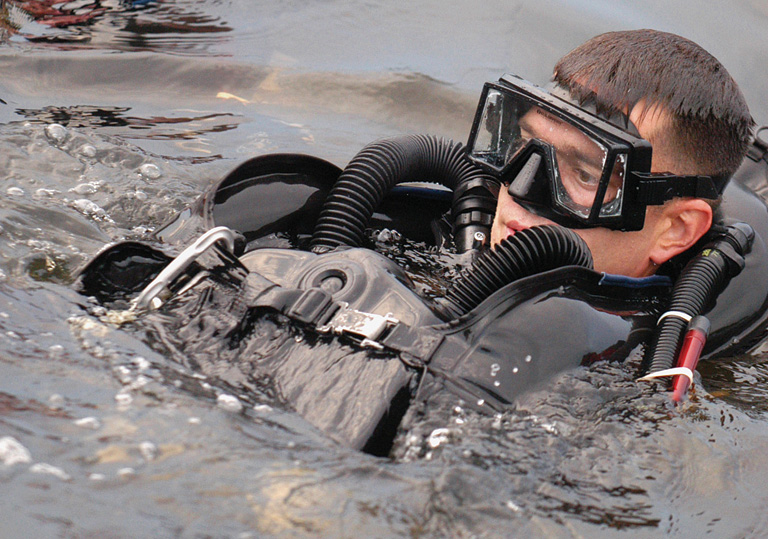Underwater breathing apparatus on:
[Wikipedia]
[Google]
[Amazon]
Underwater breathing apparatus is equipment which allows the user to breathe underwater.
The three major categories of
 A scuba set is any breathing apparatus that is carried entirely by an underwater diver and provides the diver with
A scuba set is any breathing apparatus that is carried entirely by an underwater diver and provides the diver with
 A Diving
A Diving
 The essential aspect of surface-supplied diving is that breathing gas is supplied from the surface, either from a specialized diving compressor, high-pressure cylinders, or both. In commercial and military surface-supplied diving, a backup source of breathing gas should always be present in case the primary supply fails. The diver may also wear a cylinder called a " bail-out bottle," which can provide self-contained breathing gas in an emergency. Thus, the surface-supplied diver is much less likely to have an "out-of-air" emergency than a scuba diver as there are normally two alternative air sources available.
Surface-supplied diving equipment usually includes communication capability with the surface, which adds to the safety and efficiency of the working diver.
Surface supplied diving includes diving using an umbilical with gas supply hose, lifeline strength member and communications cable, using a helmet or full-face mask, and diving with a simple air line, also known as hookah equipment.
The essential aspect of surface-supplied diving is that breathing gas is supplied from the surface, either from a specialized diving compressor, high-pressure cylinders, or both. In commercial and military surface-supplied diving, a backup source of breathing gas should always be present in case the primary supply fails. The diver may also wear a cylinder called a " bail-out bottle," which can provide self-contained breathing gas in an emergency. Thus, the surface-supplied diver is much less likely to have an "out-of-air" emergency than a scuba diver as there are normally two alternative air sources available.
Surface-supplied diving equipment usually includes communication capability with the surface, which adds to the safety and efficiency of the working diver.
Surface supplied diving includes diving using an umbilical with gas supply hose, lifeline strength member and communications cable, using a helmet or full-face mask, and diving with a simple air line, also known as hookah equipment.
 An atmospheric diving suit (ADS) is a small one-person articulated anthropomorphic submersible which resembles a
An atmospheric diving suit (ADS) is a small one-person articulated anthropomorphic submersible which resembles a
ambient pressure
Ambient or Ambiance or Ambience may refer to:
Music and sound
* Ambience (sound recording), also known as atmospheres or backgrounds
* Ambient music, a genre of music that puts an emphasis on tone and atmosphere
* ''Ambient'' (album), by Moby
* ...
underwater breathing apparatus are:
*Open circuit scuba
A scuba set, originally just scuba, is any breathing apparatus that is entirely carried by an underwater diver and provides the diver with breathing gas at the ambient pressure. ''Scuba'' is an anacronym for self-contained underwater breathing ...
, where the diver carries the gas supply, and exhaled gas is exhausted to the environment
* Rebreather scuba, where the diver carries the gas supply, and exhaled gas is recycled for further use, and
* Surface supplied diving equipment, where the gas supply is provided from the surface through a hose in a diver's umbilical
Two other types may also be identified:
* Escape sets provide a limited amount of breathing gas to allow the user to reach the surface from a disabled vessel or vehicle.
*Atmospheric pressure underwater breathing apparatus is also used in the form of armoured atmospheric diving suits, which maintain an internal pressure approximating surface pressure.
Open circuit scuba
breathing gas
A breathing gas is a mixture of gaseous chemical elements and compounds used for respiration. Air is the most common and only natural breathing gas, but other mixtures of gases, or pure oxygen, are also used in breathing equipment and enclosed ...
at the ambient pressure. Although strictly speaking the scuba set is only the diving equipment which is required for providing breathing gas to the diver, general usage includes the harness by which it is carried, and those accessories which are integral parts of the harness and breathing apparatus assembly, such as a jacket or wing style buoyancy compensator and instruments mounted in a combined housing with the pressure gauge. In open-circuit demand scuba, the diver expels exhaled air to the environment, and requires each breath be delivered on demand by a diving regulator, which reduces the pressure from the storage cylinder. The breathing air is supplied through a demand valve when the diver reduces the pressure in the demand valve during inhalation.
Rebreather scuba
 A Diving
A Diving rebreather
A rebreather is a breathing apparatus that absorbs the carbon dioxide of a user's breathing, exhaled breath to permit the rebreathing (recycling) of the substantially unused oxygen content, and unused inert content when present, of each breath. ...
recirculates the breathing gas
A breathing gas is a mixture of gaseous chemical elements and compounds used for respiration. Air is the most common and only natural breathing gas, but other mixtures of gases, or pure oxygen, are also used in breathing equipment and enclosed ...
already used by the diver after replacing oxygen
Oxygen is the chemical element with the symbol O and atomic number 8. It is a member of the chalcogen group in the periodic table, a highly reactive nonmetal, and an oxidizing agent that readily forms oxides with most elements as ...
used by the diver and removing the carbon dioxide
Carbon dioxide ( chemical formula ) is a chemical compound made up of molecules that each have one carbon atom covalently double bonded to two oxygen atoms. It is found in the gas state at room temperature. In the air, carbon dioxide is trans ...
metabolic product. Rebreather diving is used by recreational, military and scientific divers in applications where it has advantages over open circuit scuba, and surface supply of breathing gas is impracticable. The main advantages of rebreather diving are extended gas endurance, and lack of bubbles. Rebreathers are generally used for scuba applications, but are also occasionally used for bailout systems for surface supplied diving. Rebreathers are more complex to use than open circuit scuba, and have more potential points of failure, so acceptably safe use requires a greater level of skill, attention and situational awareness, which is usually derived from understanding the systems, diligent maintenance and overlearning the practical skills of operation and fault recovery.
Surface-supplied diving equipment
 The essential aspect of surface-supplied diving is that breathing gas is supplied from the surface, either from a specialized diving compressor, high-pressure cylinders, or both. In commercial and military surface-supplied diving, a backup source of breathing gas should always be present in case the primary supply fails. The diver may also wear a cylinder called a " bail-out bottle," which can provide self-contained breathing gas in an emergency. Thus, the surface-supplied diver is much less likely to have an "out-of-air" emergency than a scuba diver as there are normally two alternative air sources available.
Surface-supplied diving equipment usually includes communication capability with the surface, which adds to the safety and efficiency of the working diver.
Surface supplied diving includes diving using an umbilical with gas supply hose, lifeline strength member and communications cable, using a helmet or full-face mask, and diving with a simple air line, also known as hookah equipment.
The essential aspect of surface-supplied diving is that breathing gas is supplied from the surface, either from a specialized diving compressor, high-pressure cylinders, or both. In commercial and military surface-supplied diving, a backup source of breathing gas should always be present in case the primary supply fails. The diver may also wear a cylinder called a " bail-out bottle," which can provide self-contained breathing gas in an emergency. Thus, the surface-supplied diver is much less likely to have an "out-of-air" emergency than a scuba diver as there are normally two alternative air sources available.
Surface-supplied diving equipment usually includes communication capability with the surface, which adds to the safety and efficiency of the working diver.
Surface supplied diving includes diving using an umbilical with gas supply hose, lifeline strength member and communications cable, using a helmet or full-face mask, and diving with a simple air line, also known as hookah equipment.
Escape sets
An escape set is aself-contained breathing apparatus
A self-contained breathing apparatus (SCBA), sometimes referred to as a compressed air breathing apparatus (CABA) or simply breathing apparatus (BA), is a device worn to provide breathable air in an atmosphere that is immediately dangerous to ...
that allows its wearer to survive for a time in an environment without (sufficiently) breathable air. Early escape sets were rebreather
A rebreather is a breathing apparatus that absorbs the carbon dioxide of a user's breathing, exhaled breath to permit the rebreathing (recycling) of the substantially unused oxygen content, and unused inert content when present, of each breath. ...
s and were typically used to escape from disabled submarines that were unable to surface. One example is the Davis Submerged Escape Apparatus. Escape sets were also used ashore, e.g. in the mining
Mining is the extraction of valuable minerals or other geological materials from the Earth, usually from an ore body, lode, vein, seam, reef, or placer deposit. The exploitation of these deposits for raw material is based on the economic ...
industry, and for escape from tanks (Amphibious Tank Escape Apparatus
Amphibious means able to use either land or water. In particular it may refer to:
Animals
* Amphibian, a vertebrate animal of the class Amphibia (many of which live on land and breed in water)
* Amphibious caterpillar
* Amphibious fish, a fish ...
). The small open-circuit scuba Helicopter Aircrew Breathing Device has the similar purpose of providing breathing gas to escape from a ditched helicopter.
Atmospheric diving suits
 An atmospheric diving suit (ADS) is a small one-person articulated anthropomorphic submersible which resembles a
An atmospheric diving suit (ADS) is a small one-person articulated anthropomorphic submersible which resembles a suit of armour
Plate armour is a historical type of personal body armour made from bronze, iron, or steel plates, culminating in the iconic suit of armour entirely encasing the wearer. Full plate steel armour developed in Europe during the Late Middle Ages, e ...
, with elaborate pressure joints to allow articulation while maintaining an internal pressure of one atmosphere. Atmospheric diving suits can be used for very deep dives of up to for many hours, and eliminate the majority of significant physiological dangers associated with deep diving; the occupant need not decompress, there is no need for special gas mixtures, nor is there danger of decompression sickness
Decompression sickness (abbreviated DCS; also called divers' disease, the bends, aerobullosis, and caisson disease) is a medical condition caused by dissolved gases emerging from solution as bubbles inside the body tissues during decompressio ...
or nitrogen narcosis
Narcosis while diving (also known as nitrogen narcosis, inert gas narcosis, raptures of the deep, Martini effect) is a reversible alteration in consciousness that occurs while diving at depth. It is caused by the anesthetic effect of certain g ...
. Divers do not even need to be skilled swimmers.
References
{{Authority control Diving environmental protection equipment